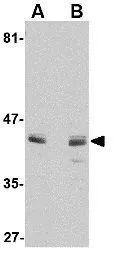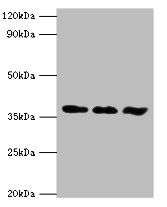
WB analysis of A549 cell lysate using GTX31779 Activin A Receptor type I antibody. Working concentration : (A) 1 and (B) 2 microg/ml
Activin Receptor Type IA antibody
GTX31779
ApplicationsWestern Blot, ELISA
Product group Antibodies
TargetACVR1
Overview
- SupplierGeneTex
- Product NameActivin Receptor Type IA antibody
- Delivery Days Customer9
- Application Supplier NoteWB: 1 microg/mL. *Optimal dilutions/concentrations should be determined by the researcher.Not tested in other applications.
- ApplicationsWestern Blot, ELISA
- CertificationResearch Use Only
- ClonalityPolyclonal
- Concentration1 mg/ml
- ConjugateUnconjugated
- Gene ID90
- Target nameACVR1
- Target descriptionactivin A receptor type 1
- Target synonymsACTRI, ACVR1A, ACVRLK2, ALK2, FOP, SKR1, TSRI, activin receptor type-1, TGF-B superfamily receptor type I, activin A receptor, type I, activin A receptor, type II-like kinase 2, activin receptor type I, activin receptor-like kinase 2, hydroxyalkyl-protein kinase, serine/threonine-protein kinase receptor R1
- HostRabbit
- IsotypeIgG
- Protein IDQ04771
- Protein NameActivin receptor type-1
- Scientific DescriptionActivins are dimeric growth and differentiation factors which belong to the transforming growth factor-beta (TGF-beta) superfamily of structurally related signaling proteins. Activins signal through a heteromeric complex of receptor serine kinases which include at least two type I ( I and IB) and two type II (II and IIB) receptors. These receptors are all transmembrane proteins, composed of a ligand-binding extracellular domain with cysteine-rich region, a transmembrane domain, and a cytoplasmic domain with predicted serine/threonine specificity. Type I receptors are essential for signaling; and type II receptors are required for binding ligands and for expression of type I receptors. Type I and II receptors form a stable complex after ligand binding, resulting in phosphorylation of type I receptors by type II receptors. This gene encodes activin A type I receptor which signals a particular transcriptional response in concert with activin type II receptors. Mutations in this gene are associated with fibrodysplasia ossificans progressive. [provided by RefSeq, Jul 2008]
- Storage Instruction-20°C or -80°C,2°C to 8°C
- UNSPSC12352203




![IHC-P analysis of formalin fixed human placenta tissue using GTX52503 Activin Receptor Type IA antibody [9J17].](https://www.genetex.com/upload/website/prouct_img/normal/GTX52503/GTX52503_20191119_IHC-P_w_23060900_750.webp)
